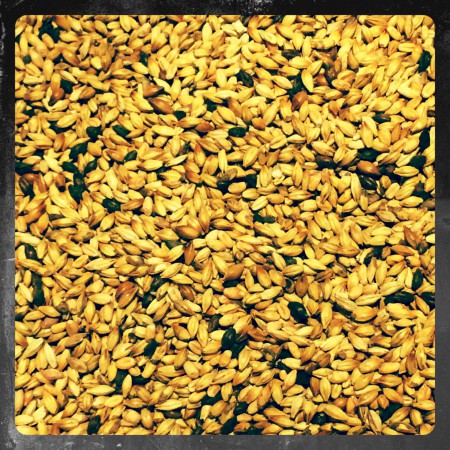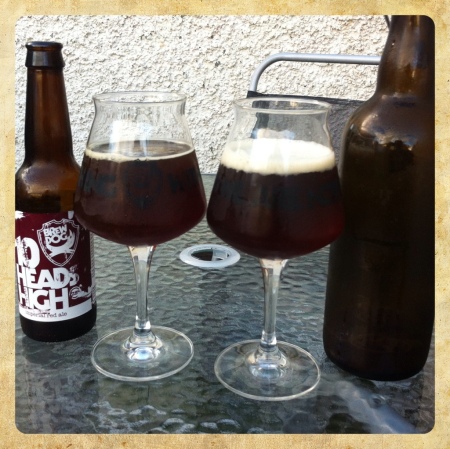This is the fourth time I’ve brewed this beer now, with only minor changes on each re-brew. I love the great balance of malts in it, though it did come out a lot darker than I wanted that last time. I did consider replacing the chocolate malt with pale chocolate (like I did with my American barleywine) but I don’t want to alter the character of the beer too much. I was worried that if I used pale chocolate malt it would simply be there as a colour adjustment, but I want to keep the hint of roast that the chocolate malt provides. So I’m going to use 20% less than last time, so 40g instead of 50g.
I’m going to leave out the massive Citra flameout addition this time and replace it with Centennial. I’m also reducing the alcohol, to make it a bit more sessionable at 6.5%. I’ve also reduced the bittering hops while keeping the same gravity to bitterness ratio. But on this recipe, I’ve also utilised BeerSmith’s ability to calculate IBUs for steep/whirlpool additions, something I normally ignore. This gives me an IBU rating of 61, which will hopefully be enough to balance all that crystal malt.
Recipe Specifications
Boil Size: 27.92 l
Post Boil Volume: 23.92 l
Batch Size (fermenter): 19.00 l
Bottling Volume: 17.00 l
Estimated OG: 1.062 SG
Estimated Color: 24.5 EBC
Estimated IBU: 61.0 IBUs
Brewhouse Efficiency: 60.00 %
Est Mash Efficiency: 73.7 %
Boil Time: 60 Minutes
Ingredients
4.900 kg Pale Malt, Maris Otter (5.9 EBC), 81.1 %
0.450 kg Caramel/Crystal Malt – 40L (78.8 EBC), 7.5 %
0.200 kg Wheat Malt, Ger (3.9 EBC), 3.3 %
0.150 kg Biscuit Malt (45.3 EBC), 2.5 %
0.050 kg Caramel/Crystal Malt -120L (236.4 EBC), 0.8 %
0.040 kg Chocolate Malt (886.5 EBC), 0.7 %
9 g Summit [17.70 %] – Boil 60.0 min, 22.6 IBUs
0.250 kg Corn Sugar (Dextrose) [Boil for 20 min], 4.1 %
30 g Cascade [7.80 %] – Boil 15.0 min, 8.1 IBUs
0.50 Items Whirlfloc Tablet (Boil 10.0 mins)
25 g Summit [17.70 %] – Boil 10.0 min, 12.6 IBUs
50 g Cascade [7.80 %] – Steep/Whirlpool 10.0, 7.0 IBUs
50 g Centennial [11.00 %] – Steep/Whirlpool, 10.8 IBUs
25 g Summit [17.70 %] – Boil 0.0 min, 0.0 IBUs
1.0 pkg Safale American (DCL/Fermentis #US-05) (400ml yeast slurry from Easy Company)
25 g Cascade [7.8 %] – Dry Hop 5.0 Days, 0.0 IBUs
25 g Centennial [11.00 %] – Dry Hop 5.0 Days, 0.0 IBUs
Mash Schedule: Bubbles’ Single Infusion, Full Body, Batch Sparge
Total Grain Weight: 6.040 kg
Mash In Add 16.21 l of water at 74.6 C 68.0 C 60 min
Sparge: Batch sparge with 2 steps (Drain mash tun , 18.01l) of 77.0 C water
28/03/2015 Mash Day – Very slow run-off from mash tun for some reason. I screwed up my strike temperature again and got a mash temperature of ~65C.
29/03/2015 – Absolutely chucking it down today, so I had to deploy the parasol on the deck where I do my boil. I used my fine mesh hop bags and got great run off from the boiler. I don’t think this has ever happened before when brewing Big Dawg. Fantastic aroma from the wort.
08/04/2015 – I had my fermenter, siphon, yeast bottles ready to transfer this beer over to secondary and dry-hop when I realised the beer was still fizzing! I did want to get the dry-hopping out of the way, so I ended up leaving the beer in primary and putting the hops into it. I used 60g Cascade pellets. A little more hops than intended because I couldn’t get any hop aroma off it. Though that could be because of the cloud of CO2 on the beer and also a terrific whiff of sulphur, which was a surprise. I’d probably been fermenting this too cold. I have the fermenter in the kitchen now anyway where it’s warm. this should finish off the fermentation nicely and allow good extraction of oils from the dry hops.
09/04/2015 – Checked the fermenter this morning and the sulphur aroma is gone, replaced by a massive blast of hops. [Update: just realised why this damn thing hadn’t finished fermenting! It’s only been in the fermenter for 11 days! I thought it had been in there longer. No matter, the leftover fermentation will drive off any oxygen present in the hops. Will remove the hops after 5 days and cold crash. I’m not sure yet if I’ll do a secondary. I could also do a second dry-hop stage, but I probably won’t.
13/04/2015 – Removed the bag of hops from the fermenter and moved to a colder room to let any residual yeast settle out.
15/04/2015 – Bottled with 138g corn sugar (18 litres at 2.6 vol). Got 17 x 750ml bottles and 11 x 500ml bottles.
07/05/2015 – I was a bit worried about how this one was going to turn out having reduced the OG significantly, but it’s really good. The flavours are great but the head retention isn’t as good as usual. Beautiful red color, the best it’s ever been – I think I have the level of roasted malt and dark crystal just right in this attempt. The bitterness is a little overwhelming but should fade over the next few weeks. A tasty beer for the summer months ahead.
17/05/2015 – This is tasting terrific. Even though I would have said that the grain and hop bills are entirely different, it tastes remarkably similar to Brewdog’s 5AM Saint, one of my favourite beers of all time. Very tasty stuff. It doesn’t quite taste the same as “regular” Big Dawg, as it’s 1% less alcohol, but a great beer nonetheless. Only a few 750ml bottles left. I must try a session version of this again.
12/08/2015 – I just accidentally happened upon a bottle of this, thinking it was a bottle of California Common. Still very drinkable, lots of bitterness there, and poenty of hop flavour, though not as intense as when first opened. Great beer, but far too much bitterness for the gravity, compared to the original incarnation of Big Dawg.



